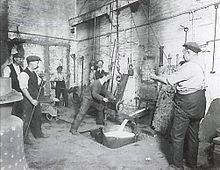Founder William Gillett | Area served Global | |
 | ||
Industry Bell and clock manufacturing Founded 1844, Croydon, United Kingdom | ||
Gillett & Johnston was a clockmaker and bell foundry based in Croydon, England from 1844 until 1957. Between 1844 and 1950, over 14,000 tower clocks were made at the works. The company's most successful and prominent period of activity as a bellfounder was in the 1920s and 1930s, when it was responsible for supplying many important bells and carillons for sites across Britain and around the world.
Contents
A successor company continues operation in Bletchingley, Surrey, under the Gillett & Johnston name, engaged in clock-making and clock and carillon repair.
History
The company traced its roots to a clockmaking business established by William Gillett in Hadlow, Kent, in the early 19th century. In 1837, Gillett moved his business to Clerkenwell, London; and in 1844 to the site in what later became known as Union Road, Thornton Heath, Croydon, which would remain its home for the next 113 years. Charles Bland became a partner in 1854, and the company subsequently traded as Gillett & Bland. In 1877, Arthur A. Johnston (c.1851–1916) bought a partnership, and shortly afterwards extended the company's output by establishing a bell foundry. The business became known as Gillett, Bland & Co until Bland's death in c.1884, when the name was changed to Gillett & Co. The name Gillett & Johnston seems to have been used from around 1887.
Arthur Johnston's son, Cyril Frederick Johnston (1884–1950), joined the company in 1902, became a partner in 1907, and took over the firm following his father's death in 1916. He developed an interest in the theory of bell-tuning, and greatly expanded the bellfounding side of the business. In 1905 he redeveloped the works, and installed a large vertical tuning lathe. He was particularly interested in the manufacture of carillons, which presented special problems of tuning distinct from those of church bells.
During the First World War, the factory suspended its regular business and became involved in the manufacture of munitions, employing over 1,250 men and women.
The firm became a limited liability company in 1925, initially trading as the Croydon Bell Foundry Ltd (although the name "Gillett and Johnston" still appeared on bells). It reverted to the name Gillett & Johnston Ltd in 1930.
Cyril Johnston resigned as managing director in 1948, following disagreements over company policy, and died suddenly two years later in 1950. Following his departure, Henry Michael Howard took over, and some bells were cast in his name. The business also now diversified into other engineering activities, and new subsidiaries (Microcastings Ltd and Bourdon Tools Ltd) were established. However, it experienced financial difficulties, caused in part by changing architectural tastes, and a falling-off in demand for traditional tower clocks and cast bells. In 1957 the business was taken into receivership and the works were closed down.
Successor company
The business was sold in 1958 to the Bath Portland Group, which already owned Synchronome, a rival office clockmaking company. For a few years, the tower clock side was established in Wembley as Gillett-Johnston Clocks Ltd. In 1962 it was bought by Cecil Hector Coombes (d. 1972), who had previously worked for Gillett & Johnston in Croydon. He returned the firm to Croydon in 1963 as Gillett and Johnston (Croydon) Ltd, basing it first in Clarendon Road (1963–1970), and then in Sanderstead Road (1970–2012). In 2012 the company moved to new premises in Bletchingley, Surrey. It remains in the Coombes family, and undertakes clockmaking, and the restoration and maintenance of tower clocks, carillons and bells.
Union Road site
The company occupied the same site in Union Road, off Whitehorse Road, Thornton Heath, Croydon, from 1844 until the closure of the works in 1957. In 1868 a tall clock tower was built as a "working advertisement", and to provide a facility in which newly cast bells could be tested: this became a prominent local landmark. Each of the clockfaces was different and unique. A carillon manufactured by the company was installed in the tower in 1920. After the company's closure in 1957, the premises were given over to other industrial uses. The main buildings, including the clock tower, were eventually demolished in 1997, the clockfaces having been removed and placed in storage. After some years standing vacant, part of the foundry building found a new purchaser in 2003 to become a church of the Emmanuel Inspirational Church of God. The greater part of the site is now occupied by a self-storage facility.
A pub on the corner of Union Road and Whitehorse Road retains the name "Ye Olde Clocktower".
Archives
Surviving records of the foundry include a register of bells cast, 1877–1919; notes relating to work on bells, 1879–1907; and 17 volumes of bell tuning books, 1907–1951. They are now held at the Museum of Croydon (ref. AR 1).
